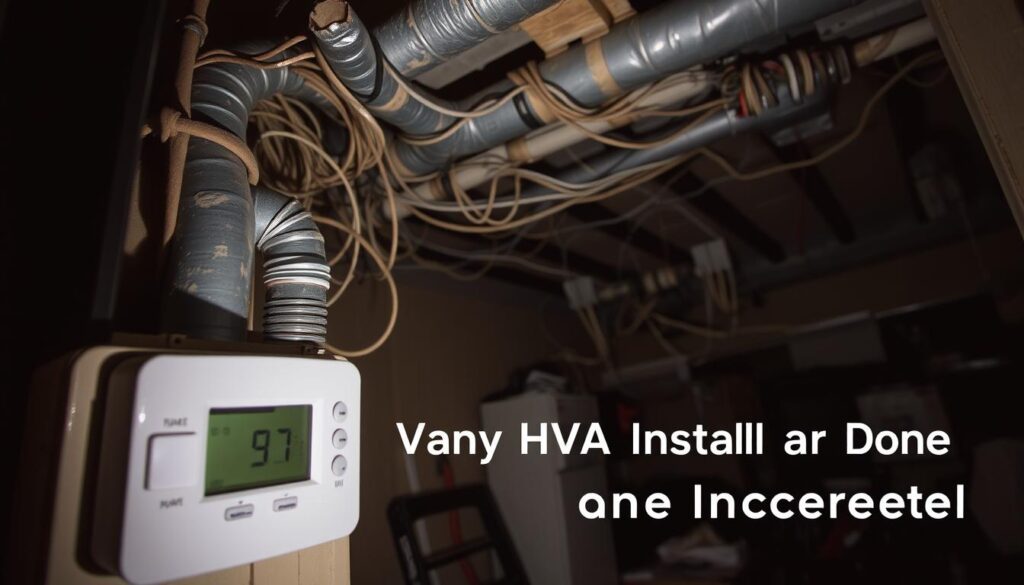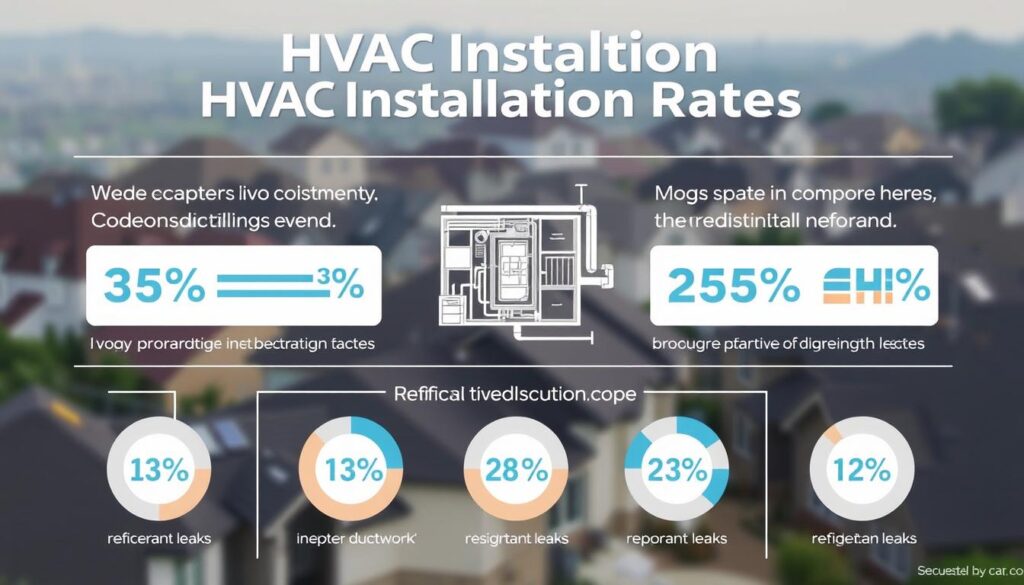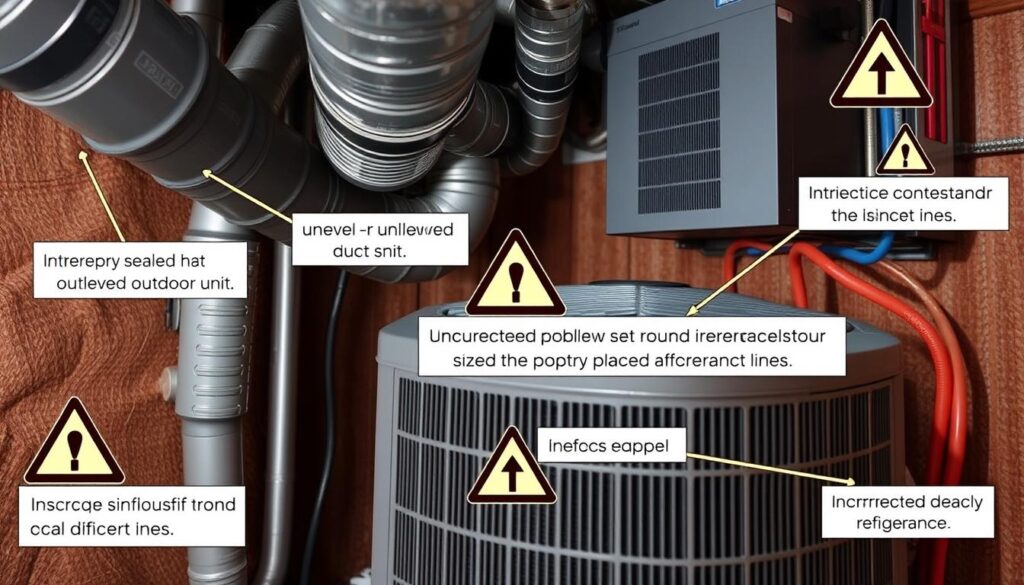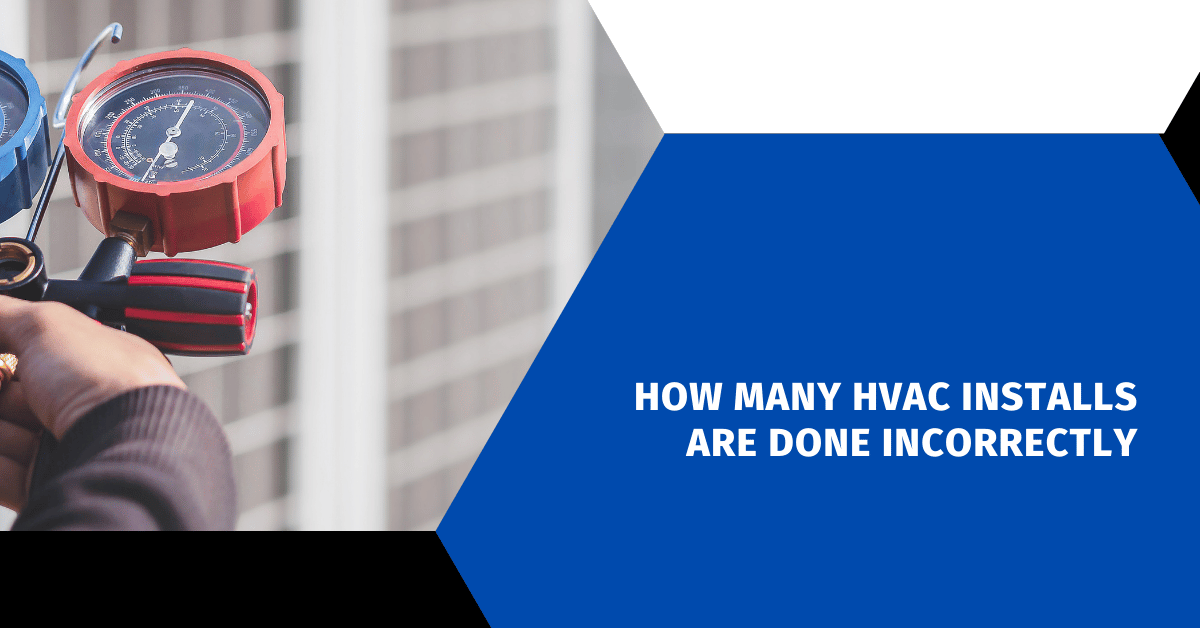How Many HVAC Installs are Done Incorrectly? Did you know nearly 97% of HVAC systems in American homes are installed wrong? This shocking fact shows a big problem with home comfort and energy use. It could be costing you thousands of dollars.

The numbers on HVAC installation errors are scary. Wrong HVAC setups can turn a reliable system into a big financial and safety risk.
Your home’s heating and cooling system is a big investment. Knowing the dangers of a bad HVAC setup can protect your comfort, safety, and money. It helps avoid unexpected problems from poor installation.
Key Takeaways
- 97% of HVAC systems have installation errors
- Incorrect installations can increase energy bills by 20-30%
- Poor HVAC setup can reduce system lifespan by up to 50%
- Improper installations may void equipment warranties
- Professional installation reduces safety risks
Table of Contents
Understanding the Scope of HVAC Installation Problems
The world of HVAC installations is full of big challenges. These can really affect your home’s comfort and how much energy it uses. Studies show that many installation mistakes could cost you thousands and waste a lot of energy.
Looking at the numbers, we see some shocking facts. In the United States, almost 141 million residential homes might have installation mistakes. It’s clear that a big part of HVAC systems have major installation errors.
Current Industry Statistics and Trends
Let’s look at some important data about HVAC installation mistakes:
- Only 23% of tested systems were charged with the perfect amount of refrigerant
- Approximately 45% of systems underperform in evaporator airflow
- Between 30% to 50% of installations contain significant errors
- Roughly 60% of residential systems are either oversized or undersized
Impact on Homeowner Investment
“A poorly installed HVAC system can cost homeowners over $1,000 in additional repairs and energy expenses throughout the system’s lifetime.”
Homeowners face big financial risks from HVAC installation mistakes. Bad installations can make systems up to 30% less efficient. This means higher energy bills and a shorter lifespan for the equipment.
Common Installation Quality Issues
The most common HVAC installation mistakes are:
- Improper refrigerant charging
- Incorrect system sizing
- Poor ductwork design
- Inadequate airflow management
Knowing these risks helps you make better choices for your HVAC system. This ensures it works well and keeps your home comfortable.
Explore Our HVAC Shop
Looking for top-rated HVAC tools, parts, and accessories? Visit our shop and find the perfect solution for your needs.
Visit the ShopThe Startling Truth: 90% of HVAC Systems Have Installation Errors
Did you know 90% of HVAC systems are installed wrong? The Advanced Energy organization says this is a big problem in the U.S. It shows a huge challenge in making sure HVAC systems are installed right.
Many important steps in HVAC installation are missed. This leads to problems with how well the system works and how much energy it uses. These mistakes can make your home less comfortable and cost more to heat and cool.
- Oversized or undersized equipment
- Inadequate airflow management
- Improper refrigerant charging
- Leaky ductwork installations
Bad HVAC installation can hurt your wallet. About 50% of heating and cooling costs come from installation mistakes. Leaky ducts can add up to 25% of your HVAC costs.
These mistakes can make your HVAC system much less efficient. It can go from a SEER 14 rating to as low as SEER 7-10. Professional technicians who know how to install HVAC systems right can avoid these problems and make sure your system works well.
The quality of your HVAC installation determines 70% of your system’s long-term reliability and efficiency.
To protect your investment, choose certified professionals. They know the best ways to install HVAC systems. Your home’s comfort and energy savings depend on it.
Explore Our HVAC Shop
Looking for top-rated HVAC tools, parts, and accessories? Visit our shop and find the perfect solution for your needs.
Visit the ShopWhy Proper HVAC Sizing Matters
Choosing the right HVAC system for your home is more than picking the biggest or smallest unit. HVAC installation standards require precise sizing. This ensures optimal performance, energy efficiency, and comfort.
Proper sizing is not just about square footage. HVAC installation regulations demand a detailed approach. They consider many factors to find the perfect system for your space.
Consequences of Oversized Systems
Oversized HVAC units cause big problems for homeowners. These systems often short cycle, leading to:
- Shortening the air conditioner’s lifespan by up to 10 years
- Uneven cooling in different rooms
- Increased wear on electrical components
- High indoor humidity levels
Effects of Undersized Equipment
An undersized HVAC system can’t meet your home’s needs. This leads to:
- Constant system operation
- High electricity bills
- Potential early system replacement
- Decreased indoor comfort
Professional Load Calculation Importance
Professional load calculations are key to finding the right HVAC system. They consider:
- Home square footage
- Number of residents
- Insulation quality
- Interior features
- Local climate conditions
Investing in a professionally sized HVAC system can save you thousands in energy costs and prevent premature equipment failure.
Common Causes Behind Poor HVAC Installations
HVAC installation errors can cause big problems for homeowners. Knowing why these mistakes happen helps avoid expensive issues that hurt system performance and efficiency.
Several key factors lead to faulty HVAC installations:
- Lack of professional training for technicians
- Time constraints leading to rushed jobs
- Inaccurate load calculations
- Inadequate equipment knowledge
A study from the National Institute of Standards and Technology found that bad HVAC installation can raise household energy use by up to 30%. The main installation mistakes include:
| Installation Error | Potential Consequences |
|---|---|
| Leaky Ductwork | Increased energy consumption |
| Incorrect Refrigerant Charge | Reduced system efficiency |
| Oversized Equipment | Higher operational costs |
| Restricted Airflow | Decreased system performance |
Choosing certified pros is your best defense against HVAC installation errors. Look for technicians with NATE certification. It shows they know HVAC systems well and install them correctly.
By knowing these common causes, you can safeguard your investment. Make sure your HVAC system works at its best. Always choose quality installation over cheap, quick fixes.
Explore Our HVAC Shop
Looking for top-rated HVAC tools, parts, and accessories? Visit our shop and find the perfect solution for your needs.
Visit the ShopThe Role of Airflow in System Performance
Your HVAC system’s performance depends a lot on airflow. Knowing how air moves can help you avoid common mistakes in HVAC installation. These mistakes can affect your home’s cooling and heating.
Airflow is key to your heating and cooling system’s health. If air doesn’t move well, your system won’t work efficiently. This can lead to higher failure rates and less comfort.
Return Air Vent Requirements
Where you place return air vents is very important. Experts give specific advice to keep air flowing well:
- Put one return register per room when you can
- Make sure the vent size matches your system’s power
- Don’t block return air paths with furniture or things
Ductwork Design Considerations
Designing ductwork is critical for HVAC quality. Important points include:
- Keep ducts short to keep air moving
- Seal ducts well to stop air leaks
- Size ducts right for even air flow
Mechanical Room Ventilation Needs
Your mechanical room needs special care for your HVAC to work best. Combustion air supply is vital for furnaces and other gear. It keeps them safe and running well.
Good airflow isn’t just about feeling comfortable—it’s also about keeping your system running long and saving energy.
By knowing about airflow, you can spot and fix installation problems. This ensures your HVAC system works at its best.
How Many HVAC Installs are Done Incorrectly: Industry Data Analysis

The world of HVAC installations shows a shocking truth. Recent studies reveal big problems with system performance and efficiency.
Industry research has uncovered widespread HVAC installation errors:
- 70-90% of residential air source heat pumps and central air conditioners waste energy.
- Up to 30% more energy is used because of bad installations.
- About 20.7 TWh of energy is wasted yearly in U.S. single-family homes.
The effects of HVAC installation failures are clear when we look at specific numbers:
| System Type | Error Rate | Energy Impact |
|---|---|---|
| New HVAC Systems | 10.5% Power Measurement Error | 9% Additional Energy Use |
| Existing HVAC Systems | 18.0% Power Measurement Error | Up to 30% Energy Waste |
Experts say fixing installation problems can greatly boost system performance. The Department of Energy says fixing common mistakes can improve air conditioning and heat pumps by up to 24%.
Proper installation is not just about efficiency—it’s about ensuring your HVAC system performs at its absolute best.
These numbers highlight why professional, accurate HVAC installation is key. It ensures energy efficiency, lowers costs, and keeps systems running well.
Explore Our HVAC Shop
Looking for top-rated HVAC tools, parts, and accessories? Visit our shop and find the perfect solution for your needs.
Visit the ShopFinancial Implications of Improper Installation
Improper HVAC installation can cost you a lot more than you think. Not following HVAC installation standards can lead to big financial problems. These issues go beyond the initial cost of setting up your system.
The effects of bad installation are serious. They can hurt your wallet in many ways:
- Increased energy use, up to 50% more than a well-installed system
- Repair costs can be $1,500 to $3,000 for big parts
- System lifespan can be cut in half
- Manufacturer warranties might be voided
Following HVAC installation best practices is key to saving money. Hiring unqualified installers can lead to big, long-term expenses. A system that’s not the right size or not sealed well will waste a lot of energy. This means your utility bills will go up a lot.
HVAC installation rules are in place to avoid these costly errors. Not following these rules can lead to:
- Frequent system repairs
- Premature equipment replacement
- Inefficient cooling and heating
- Higher long-term maintenance expenses
Even though professional, high-quality installation might cost more upfront, it saves you a lot in the long run. Your HVAC system is a big investment in your home. Make sure to get it installed by experts to protect it.
Key Signs of an Incorrectly Installed HVAC System
Spotting the signs of a bad HVAC installation can save you money and keep your home comfy. A system put in wrong can cause many problems. These issues can affect your home’s comfort, energy use, and how well it works.

Knowing the signs of hvac installation mistakes can help you fix problems fast. Here are the important signs to look out for:
Performance Indicators
- Inconsistent Temperature Distribution: Almost half of homeowners say their heating or cooling isn’t even. This is a big sign of a bad HVAC installation.
- Frequent system cycling or short-running periods
- Inability to keep a steady indoor temperature
- Poor humidity control in your living spaces
Physical Warning Signs
- Unusual noises when the system is on
- Visible damage to HVAC parts
- Excessive vibrations when the system runs
- Water leaks around the unit or ductwork
Energy Consumption Red Flags
A bad HVAC installation can really raise your energy bills. Watch out for these signs:
- Unexpectedly high utility bills (up to 30% increase)
- Rapid system wear and early part failure
- Constant system strain and poor energy use
- More frequent repair needs
By keeping an eye out and getting a pro to check, you can catch these signs early. This could save you thousands in repair or replacement costs later on.
The Importance of Professional HVAC Installation
Professional HVAC installation is key. It ensures your system works at its best. DIY efforts often lead to costly errors, with 70% of homeowners facing issues within a year.
Professional installers follow strict standards. They know how to size, place, and install systems right. They also meet local regulations. This is why they have a 90% success rate, unlike DIYers.
Your home’s comfort and energy use depend on proper HVAC installation. Wrong installations can raise energy use by 30% and void warranties. Choosing a licensed pro saves money and ensures your system lasts longer.
Trusting experts is vital for your HVAC investment. They meet manufacturer specs and extend your system’s life by 15-20%. Avoiding $1,000 repair costs shows the value of professional help.

